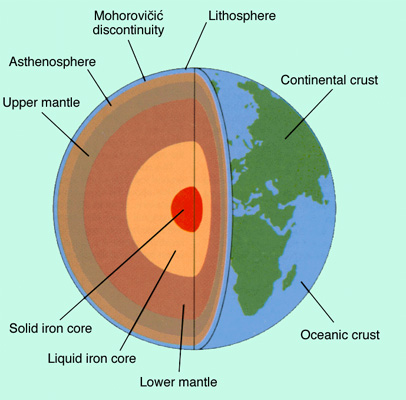1. n. [Geology]
Also known as plate tectonics, the unifying geologic theory developed to explain observations that interactions of the brittle plates of the lithosphere with each other and with the softer underlying asthenosphere result in large-scale changes in the Earth. The theory of plate tectonics initially stemmed from observations of the shapes of the continents, particularly South America and Africa, which fit together like pieces in a jigsaw puzzle and have similar rocks and fossils despite being separated by a modern ocean. As lithospheric plates heat up or cool down depending on their position, or their tectonic environment, relative to each other and to warmer areas deeper within the Earth, they become relatively more or less dense than the asthenosphere and thus tend to rise as molten magma or sink in cold, brittle slabs or slide past each other. Mountain belts can form during plate collisions or an orogeny; diverging plates or rifts can create new midoceanic ridges; plates that slide past one another create transform fault zones (such as the San Andreas fault); and zones of subduction occur where one lithospheric plate moves beneath another. Plate tectonic theory can explain such phenomena as earthquakes, volcanic or other igneous activity, midoceanic ridges and the relative youth of the oceanic crust, and the formation of sedimentary basins on the basis of their relationships to lithospheric plate boundaries. Convection of the mantle is postulated to be the driving mechanism for the movement of lithospheric plates. Measurements of the continents using the Global Positioning System confirm the relative motions of plates. Age determinations of the oceanic crust confirm that such crust is much younger than that of the continents and has been recycled by the process of subduction and regenerated at midoceanic ridges.
Synonyms: plate tectonics
See related terms: active margin, aulacogen, basin, core, craton, earthquake, eustasy, Global Positioning System, isostasy, midoceanic ridge, normal fault, orogeny, passive margin, preservation, rift, rock, sedimentary basin, sequence stratigraphy, transform fault, Wadati-Benioff zone
